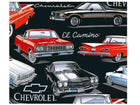Brakes are something you need professional help and experience with to ensure the safety of your vehicle.
Here are some of the most common questions we get asked about disc brake conversions:
Why are disc brakes better than drum brakes?
Disc brakes are not subject to fade from heat or water. Also, disc brakes do not drift out of adjustment.
I have drum brakes with 14’’ wheels now, if I change to disc brakes can I keep them 14’’ wheels?
In most cases, no. Typically you will need to go to a 15’’ wheel when converting to disc brakes. However, there is an emerging low level supply of bracket kits to allow the 14’’ rims but not always common with GM or Ford engineered and proven matching components.
Which calipers are better? 4 piston or single piston?
Single piston calipers are the standard. They are much more reliable since there’s only one piston which could possibly leak, not four. Most all have the industry backing.
Do disc brakes require more pressure than drum brakes?
Yes and you will need at least 1000 psi to the front wheels.
Is a power booster required with disc brakes?
No, although a power booster gives a good pedal feel, manual brakes work fine.
If I add disc brakes, will I need a proportioning valve?
Yes. The addition of a proportioning valve is a must. Without it, your braking system will not operate properly.
Can I use my drum brake master for disc brakes?
No, for two reasons: 1. You will not have enough pressure or volume. 2. The drum brake master will have a residual valve that will cause the disc brakes to drag.
Can I reuse my old drum brake valve when I change over to disc?
No, you must use a disc/drum valve.
I converted to disc brakes and I can’t get pedal pressure, it goes to the floor, what do I do?
Check the bleeder screw orientation on the callipers. The bleeder screw must be on top in the 12:00 position. If it is not, you will not be able to move all the air from the system.
How to diagnose a problem with your disc brakes?
-
Seek professional help.
-
Disconnect the brake lines from the master cylinder while leaving the cylinder on the vehicle.
-
Obtain solid plugs for the master cylinder outlets with the correct threads.
-
Plug both master cylinder outlets and try the pedal. If the pedal is very spongy or goes to the floor, the pedal is bad. If you have a good firm pedal, then the pedal is fine.
-
If the master is fine, connect the line to the front portion of the system and try the pedal again. If the pedal remains firm, then the front part of the system is fine. If the pedal goes to the floor, the problem is with the front part of the system.
-
If the pedal is fine with the front part of the system connected, then connect the rear portion. If the pedal goes to the floor, then the problem is in the rear.
-
Once you know which portion of the system has the problem, it will be easier to fix it.













